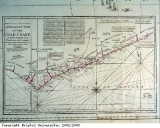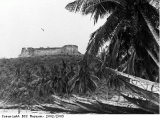Dealings between traders
The British and other European powers had slaving forts on the West African coast, which were bases for slave trading companies. Enslaved Africans were brought to the forts by the African traders to be sold to the Europeans. They would be held there until the slave ships arrived from Europe to purchase slaves. The forts, which were permanently staffed by both white and black workers and soldiers, often ran short of essential supplies. This meant that the fort officials were usually dependent on the co-operation of the local rulers to buy supplies from the local community. Where there were no forts nearby, the European slave ships would sail around the coast, stopping to trade with individuals. The African slave traders would go out by canoe to the slave ships to trade with the European captains.
The map pictured here is of the Gold Coast , now Ghana, West Africa. It shows the trading forts built and maintained by the different European countries, which traded for slaves with the locals. The map is from a larger map showing the whole continent of Africa. Trading forts gave European companies like the British Royal African Company, in London, a secure base for their slave-trading activities. Also shown here is a photograph taken in the 1950s of an old trading fort at Dixcove. Records show that the Bristol ships Molly (1748), Active (1789) and Lovely Lass (1792) bought slaves from the trading fort at Dixcove.
The British government at the time tried to gain favour with some of the more important African traders by inviting their sons to England to learn English. Some close trading relationships and even friendships did grow between the African and European slave traders, though such friendship was often tinged with caution and suspicion on both sides.




